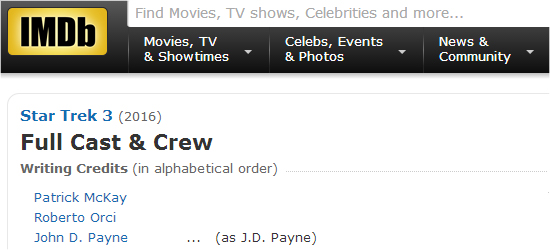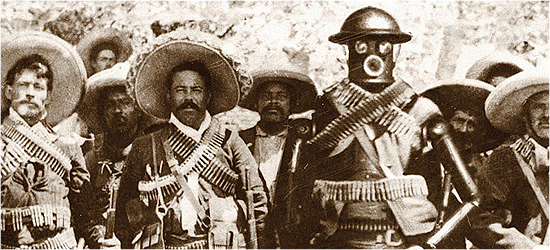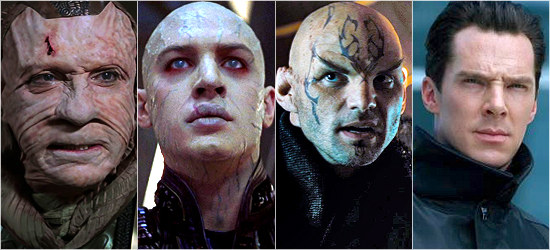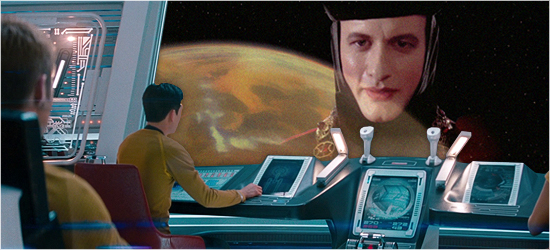Ever since Patrick McKay and J.D. Payne were first named as co-writers on 2016’s Star Trek sequel – joining returning writer (and now director) Roberto Orci – the franchise fanbase has been buzzing with questions about these newcomers: Who are they? What other work have they produced? Just what do they know about Star Trek, anyhow?
Aside from a few brief conversations and video clips released back in March, we haven’t heard much from this new writing team… and we thought we’d better change that!
The TrekCore team is proud to release our EXCLUSIVE, in-depth interview with McKay and Payne, the first conversation published ANYWHERE with the scribes who have been working tirelessly to shape the next adventures of Captain Kirk and the crew of the USS Enterprise.
![]()
TREKCORE: First of all, tell us a little about your backgrounds. How did you end up paired together as a writing team?
Patrick McKay: Well, J.D. and I have been writing together for about seventeen years. We met in junior high; we went to the same junior high and high school. We were on the debate team together, and sort of knew each other peripherally, and through other friends. I guess around our junior year in high school, J.D. had written a play, and he invited me to help direct it for the festival at our school.
At the time, you know, we had both been independently pursuing creative work. I was very much a film buff, into Scorsese and other cool, edgy filmmakers, and was sort of making my own little backyard silly movies; J.D. was always writing short stories and novels and with a very Twilight Zone sort of sci-fi style.
So we directed this play together, and it was a lot of fun, so we decided that for the next year’s festival, we’d write one together from the ground up. We quickly found that it was sort of kismet, and that we both had talents that kind of… what’s the right word for it, J.D.?
J.D. Payne: They complemented each other. It was the kind of thing where it was just instantly fun and easy and rewarding to do together. There were these things that I’d been working through in my own work that I hadn’t quite known how to tackle, but Patrick came on and brought all of these other cool things to it.
Being able to find that kind of thing was a very special and unique kind of thing, and when you meet your writing partner that young, it’s sort of like falling in love with your high school sweetheart, somehow. You don’t even really know it, but figuring out how the two of you come together with all of the various creative instincts, and figuring out how you’re going to tackle these problems is something pretty cool.
Patrick McKay: Definitely. And you’re learning to do this at a young enough age that you’re developing a voice together, and stumbling and seeing what works or doesn’t work together… it was great, and very much a once-in-a-lifetime kind of thing. After finishing one of the first things we wrote, we were like, “Oh, wow – we like this.” That led to more things through college, and the rest is history.

TREKCORE: Speaking of that history, we know that you guys have been working on different projects for several years now – but all the credits that the general public gets to see is whatever shows up on IMDB… which, to be honest, is a pretty sparse list at the moment.
Many fans have expressed their interest in knowing more about your prior professional work – could you talk about what you guys have been working on for the past few years?
J.D. Payne: Well, throughout our twenties, we wrote basically one screenplay a year – we wrote about seven or eight of them before we even got agency representation.
We tried our hands at a bunch of different genres, some of those indie, navel-gazing type of comedies, some period epics – you know, ‘love and loss in the time of revolution’ – we were all over the map, basically. We found that where we really came together in terms of our visions and talents were these big, big summer movies that also have a good amount of heart and emotion.
Around 2008, we were in this sort of conundrum where the things that the market was responding to most were these pre-branded things in the public domain; stuff that people already had awareness of. So we took the story of King Midas and did sort of a big origin story – kind of the Batman Begins version of King Midas, if you will.
Up until this point, it had been a fairly uncomplicated morality tale, but we were interested in seeing what would happen if we were to take that and make it into a sort of really cool, grounded, emotionally-epic kind of a movie? So we took it and turned into this big, dark, interesting epic story.
Patrick McKay: It took a long time to write that script – something like two years.
J.D. had been living in Los Angeles, I was going to grad school for creative writing in Washington, D.C., and we’d been working on all these things in the background. J.D. had been handing our scripts to anyone he could get to read them out in Hollywood, hoping somehow to get somebody who could pass them on to an agent, or somebody in the industry, an actor, somebody.
Finally, it was this script Midas that started going from the people he gave it to up to those people’s bosses. People started reading it, they wanted to be a part of it and get it going – and out of that we got a manager and an agent. That script then became our calling card for a little while, but we weren’t able to sell it to a studio or get any studio assignment work off of it, which is the way it normally works.
You write an original script, people like it, then they hire you to rewrite one of their project. This one didn’t quite land, so we were then looking to write another script. What that one ended up becoming was a script called Goliath, which should be on the Internet somewhere with our names on it. That we sold in 2010, and that was sort of our big break.
Off of that one, we started working on assignment. We got a job at Paramount for a movie called Deadliest Warrior, which was sort of a big Magnificent Seven or Avengers-type action movie, where you took warriors from different time periods, and see who would win if they fought – like a ninja vs. samurai, or a Viking vs. an Apache from the Old West – sort of a greatest-hits team of warriors from throughout history; that was our first big assignment.
That was for Paramount, so off of that, we started looking for other work there – and one of Paramount’s big producers was J.J. Abrams at Bad Robot.

J.D. Payne: Basically, we went in and had a general meeting with Bad Robot; they said to us, “You know, we don’t have a ton of projects up your alley at the moment, but we do have this graphic novel we have the rights to called Boilerplate.” It’s the story of a late 19th Century robot that goes around meeting historical luminaries and having interesting adventures.
Patrick McKay: It’s a faux textbook, purporting to be the ‘true’ historical story of this robot, where the comic book artists came up with the character and they insert him into old photos like Forrest Gump. It’s really kind of cool, and when the executive at Bad Robot showed us the book, we fell in love with it and knew we wanted to write it. We got that job and wrote the script, and it was one of the greatest and most fun creative experiences we’ve ever had. It’s a great character and a fun world to play around in.
J.D. Payne: Also, it was a wonderful creative process. It was one we had a lot of inspiration for, but was also one where we felt a real sense of connection with the producers, which is a special thing. Finding a writing partner you really gel with is unique and special, but finding producers that you share common visions with is just as cool.
Patrick McKay: Following that, we did a couple of movies we that you might not have heard of; I don’t know if there’s anything about them online. One is a draft of a movie called Micronauts, which is based on a Hasbro property that Bad Robot was producing. That one is sort of a big space epic in line with Alien and Star Wars; it’s a big cool summer science fiction movie. We also did a movie for Warner Brothers called Law Zero.
J.D. Payne: That one’s sort of like Blade Runner meets Vertigo. It’s a very noir-ish kind of cinema, where we really started moving more towards ‘hard’ sci-fi. That has this crazy world where a robot uprising is building, a cool exodus story, and a bunch of other things along with it. We developed Law Zero with a couple of directors from Spain, Bruno Zacarias and Miguel de Olaso, and had a really good time finding the story and its emotional through-line.

TREKCORE: Let’s move on to your relationship with Star Trek. You guys are both big Next Generation fans going way back, but what is your experience with the Original Series, or the spin-offs – Deep Space Nine, Voyager, and Enterprise?
J.D. Payne: Well, Patrick grew up watching the Original Series at home.
Patrick McKay: I would say that one of the things we really bonded over was our shared love of Star Trek. My parents were massive Trek fans before I was born – the kind who waited in line in the snow to see The Motion Picture in ’79. They’re true fans, so I grew up around them, loving all of the classic episodes, and going to see the movies in the theater, and you know, my parents also loved Star Wars and Indiana Jones, and all those other chestnuts from the period.
J.D. Payne: I always thought Patrick’s house was the most awesome place because they had that telephone that was shaped like the starship Enterprise. That was just SO cool.
Patrick McKay: Completely true. I’ve probably seen every episode of the Original Series, I’ve seen the movies many, many times; I remember when The Next Generation was premiering, it was such a big deal. I watched at least the first couple of seasons – you know, I do actually remember watching “Best of Both Worlds” as it aired. That was great.
Then, I was becoming a teenager and – as many teens do, you reject whatever your parents like – so I went through a few years where I was like, “You know, I don’t even LIKE Star Trek!” But I very much came back to it in a big way as I got older. But JD – now HE is the real die-hard Next Gen fan.
J.D. Payne: Yeah, definitely. I sort of discovered Trek at this pivotal time for me. I was about fifteen and socially, I was just cool enough to know that Star Trek was kind of dorky – but I was also just dorky enough to know that it was pretty cool! For me, it was something I really discovered on my own; my parents didn’t introduce it to me.
I think that the first episode I ever saw was “Frame of Mind,” and it was like discovering jazz or something. How has this been out there my entire life and I’d never seen it before?! After that, I was just plugged into it. I would tape it off of television, edit out the commercials, and I had my own little library of Star Trek and got super, super into it. I just loved the sense it had for the possibility of what could be ‘out there.’
After that, I definitely also got into Deep Space Nine and Voyager; I would watch those as they were airing throughout high school. When I went to college, though, I was so crazy my freshman year at Yale studying applied physics and dealing with school fourteen hours a day chained to my desk that I didn’t even have a TV in my dorm room. I haven’t watched much of Enterprise, but I’ve seen a few episodes.
Patrick McKay: I think Riker shows up in the Enterprise finale. I feel like I saw that one.
TREKCORE: Yeah, that’s kind of a controversial thing; a lot of people look at the episode that aired the week before as the ‘true’ series finale.
Patrick McKay: (Laughs) Oh sure, I can believe that!

TREKCORE: Over the last fifteen years or so, we’ve had four Trek films in a row where the evil guest star, bent on revenge, has this giant ship that the Enterprise crew has to destroy in order to save the day – and there hasn’t been a Trek movie without a headlining villain since 1986’s Star Trek IV: The Voyage Home.
Do you think that the modern, “action movie” style of Trek film is a necessity to draw in today’s movie-going audience, or could a more intangible threat – like V’GER from The Motion Picture, or the “save the whales” time travel mission from Star Trek IV – still succeed in 2014?
Patrick McKay: I’d sure like to think so!
You know, people always talk up “Wrath of Khan! Wrath of Khan!” – and while I love Star Trek II, and I’ve seen it so many times, I also REALLY love Star Trek III and Star Trek IV. Those are movies that have a little bit more of the character relationships and the humor and some more of the speculative sci-fi elements. And sure, there are certainly a lot of problems you can point to in The Motion Picture, but I love that movie too. I think it’s a cool movie, and it’s totally Star Trek.
There are big, ambitious, complex movies that also have a huge audience. Take The Dark Knight – certainly, that’s a very villain-centric movie, but that’s also very ambitious movie. Inception – does that one even have a villain? That’s such a complex picture, and that ended up doing like $800 Million worldwide. There’s a lot of ways to do it.

J.D. Payne: Yeah, and that’s one of the things that I think is so wonderful about Star Trek. It’s a universe in which there are a lot of different possibilities in terms of what make a good story.
I look back at some of those Next Generation episodes where you have these shows that are as big and crazy as “Yesterday’s Enterprise,” “The Best of Both Worlds,” “Chain of Command,” or “All Good Things,” but there are also these intimate episodes like “Tapestry” and “The Inner Light” – or “Data’s Day,” where you have Data just hanging around with his cat!
Editor’s note: He didn’t even need to pause for a second to name those episode titles.
Star Trek can do so many different things and do it well, that you have just so many colors on that palette to paint with – and I think that for us, in terms of what we’re thinking for the next one, nothing’s really off the table.

